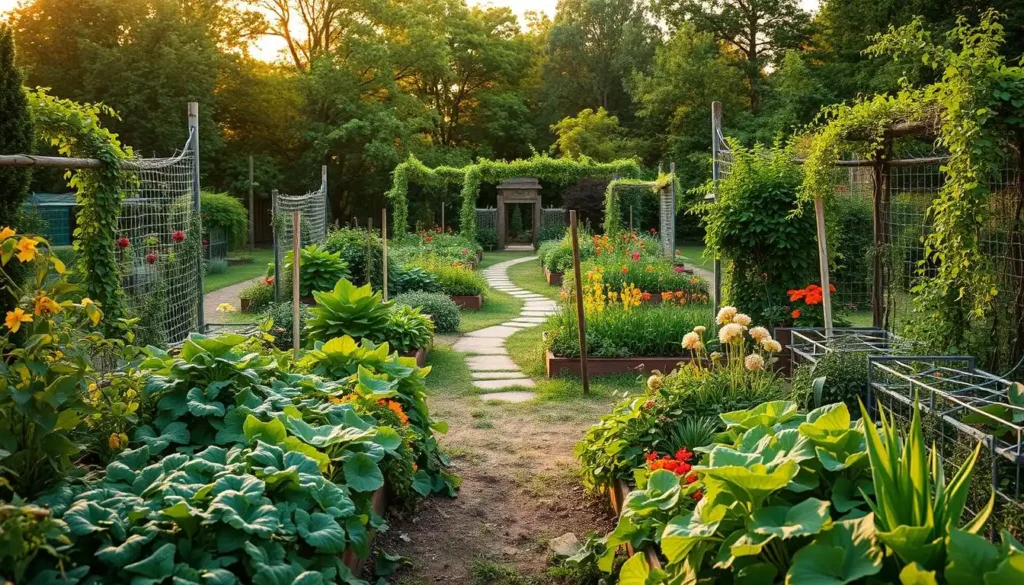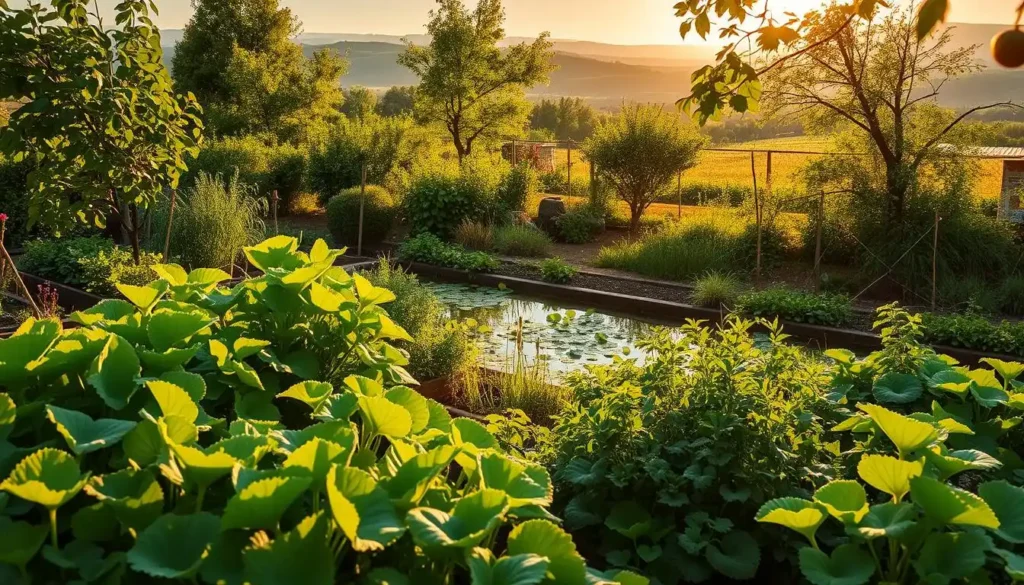Are you looking to create a sustainable and thriving garden without the hassle? You’re in the right place! Permaculture garden design is an innovative approach to gardening that works with nature, not against it. By implementing simple and effective techniques, you can create a lush and productive outdoor space that requires minimal maintenance.
As a beginner, getting started with permaculture gardening can seem daunting. However, with the right guidance, you can easily design and maintain a beautiful and functional garden. In this article, we’ll walk you through the basics of permaculture garden design and provide you with the tools you need to get started.
Table of Contents
Key Takeaways
- Create a sustainable garden that works with nature
- Implement simple and effective techniques for a thriving outdoor space
- Learn the basics of permaculture garden design
- Get started with permaculture gardening as a beginner
- Design and maintain a beautiful and functional garden
What Is a Permaculture Garden? Nature’s Blueprint Explained
A permaculture garden is more than a plot of land. It’s a thriving ecosystem that works with nature. By using permaculture principles, you can make a garden that’s good for you and the planet.
The Core Principles of Permaculture
Permaculture has core principles for designing and managing gardens. These principles are based on ethics and practices that respect nature.
Ethics: Earth Care, People Care, Fair Share
The ethics of permaculture focus on three main points: Earth Care, People Care, and Fair Share. Earth Care means taking care of the land and its resources. People Care ensures the needs of individuals and communities are met. Fair Share promotes sharing resources and surplus, leading to equity and sustainability.
Working With Nature, Not Against It
Permaculture teaches us to observe and work with natural systems. This approach helps create a balanced ecosystem that’s resilient and productive.

How Permaculture Differs from Conventional Gardening
Permaculture gardening is different from conventional gardening. It focuses on creating a self-sustaining ecosystem. Key differences include:
- Emphasis on biodiversity and ecological balance
- Use of natural and organic methods
- Designing with nature, rather than against it
- Creating closed-loop systems that minimize waste
By adopting permaculture principles, you can turn your garden into a thriving, sustainable ecosystem. This ecosystem provides many benefits for you and the environment.
The Remarkable Benefits of Permaculture Gardening
Starting your permaculture journey brings many benefits. It’s not just about growing plants. It’s about making a sustainable ecosystem that helps you and the planet.
Environmental Advantages
Permaculture gardening helps the environment. It saves water, cuts down waste, and boosts biodiversity. It uses natural ways to fight pests and diseases, avoiding harmful chemicals.
Economic Benefits for Your Household
Permaculture gardening saves money. You grow your own food, cutting down on grocery bills. It also makes your property more valuable with its beauty and productivity.
Creating Resilient and Self-Sustaining Systems
Permaculture gardening builds strong, self-sustaining systems. It creates diverse ecosystems that can face challenges. Key parts of this are:
- Reduced Maintenance Over Time: As your garden grows, it needs less care.
- Natural Pest Management: It encourages natural predators to fight pests, cutting down pesticide use.

Permaculture gardening is more than a garden. It’s a step towards a sustainable future. It offers many benefits for the environment, your wallet, and your garden’s health.
Permaculture Garden Design: Creating Your Master Plan
Starting a permaculture garden is an exciting journey. It begins with a thoughtful master plan. This stage is key as it lays the groundwork for a thriving, sustainable ecosystem.
Assessing Your Site’s Unique Characteristics
Before digging, assess your site’s unique features. Look at your land’s topography, noting slopes, valleys, and flat areas. Also, consider the existing plants, soil type, and microclimates in your garden.
Key factors to assess include:
- Soil quality and type
- Existing flora and fauna
- Microclimates and frost pockets
- Access to water sources
Mapping Sun, Wind, and Water Patterns
It’s crucial to understand and map your site’s environmental patterns. Note how sunlight falls, wind directions, and water flow during rain.

Designing with Permaculture Principles in Mind
After assessing and mapping, apply permaculture principles to your design. This means creating a holistic plan that boosts efficiency and productivity.
Relative Location and Connections
Think about the relative location of elements in your garden. For example, place shade-loving plants near trees or structures that cast shade.
Multiple Functions for Each Element
Each element in your garden should have multiple functions. For instance, a pond can provide irrigation, be a wildlife habitat, and offer fish for food.
| Element | Primary Function | Secondary Function |
|---|---|---|
| Pond | Irrigation | Wildlife Habitat |
| Compost Pile | Waste Management | Soil Fertilization |
By designing with these principles, you’ll create a sustainable, productive ecosystem.
“Permaculture is a philosophy of working with, rather than against nature.”
Essential Elements of Permaculture Garden Layout
To make a permaculture garden beautiful and useful, you must know its basic layout rules. A good permaculture garden layout is key to getting the most out of your space and keeping it low maintenance. It’s about arranging your garden well and using the environment to your advantage.
Zones: Organizing Your Space Efficiently
Zoning is a key idea in permaculture design. It helps you arrange your garden based on how often you use it and what it needs. By dividing your garden into zones, you can use your time and resources better.
Zone0-1: High-Traffic Areas
Zone 0 is your home, the heart of your permaculture system. Zone 1 includes spots you visit often, like vegetable and herb gardens. These areas need careful planning to be both productive and easy to care for.
Zones2-5: Less Frequently Visited Areas
Zones 2 through 5 are for less often visited spots. They’re for orchards (Zone 2), larger animals and woodlots (Zone 3), semi-wild areas for foraging (Zone 4), and wilderness (Zone 5). Knowing how to use each zone helps make your garden more efficient.
Sectors: Working with External Elements
Sector analysis is about understanding and working with things like sunlight, wind, and water flow. By studying these sectors, you can design your garden to use these elements to your advantage and avoid their negative effects.
Edges and Patterns in Your Garden Design
Edges, where different ecosystems meet, are very productive in a permaculture garden. Using these edges and creating patterns that follow nature can increase biodiversity and make your garden more efficient.
Here’s a simple table to show the different zones and what they’re for:
| Zone | Description | Typical Uses |
|---|---|---|
| Zone 0 | Your home | Central hub |
| Zone 1 | High-traffic areas | Vegetable gardens, herb gardens |
| Zone 2 | Orchard and larger plants | Orchard, larger perennials |
| Zone 3 | Larger animals and woodlots | Pasture, woodlots |
| Zone 4 | Semi-wild areas | Foraging, wildlife habitat |
| Zone 5 | Wilderness areas | Wildlife habitat, conservation |
Soil Building Strategies for a Thriving Permaculture Garden
Healthy soil is key to a successful permaculture garden. It’s where the magic starts, and your plants’ health and growth depend on it.
No-Dig Gardening Methods
No-dig gardening keeps the soil intact, preserving its structure and life. It involves adding layers of organic matter on top. This breaks down over time, enriching the soil without tilling.
Australian permaculture expert Bill Mollison said, “The earth is not something we inherit from our parents, but something we borrow from our children.” This shows why sustainable practices like no-dig gardening are vital.
Composting and Mulching Techniques
Composting and mulching are essential for healthy soil. Composting turns waste into a nutrient-rich resource. Mulching keeps moisture, controls weeds, and regulates soil temperature.
Sheet Mulching (Lasagna Gardening)
Sheet mulching, or lasagna gardening, layers organic materials like leaves and kitchen scraps on the soil. It creates a nutrient-dense soil amendment that boosts microbial activity.
Compost Tea and Natural Fertilizers
Compost tea is a liquid made by steeping compost in water. It’s full of beneficial microbes that improve soil fertility and structure.
| Composting Method | Description | Benefits |
|---|---|---|
| Hot Composting | Involves actively managing the compost pile to maintain high temperatures. | Breaks down materials quickly, kills pathogens. |
| Cold Composting | A more passive approach, where materials are added to the compost pile over time. | Less labor-intensive, still produces nutrient-rich compost. |
Working with Soil Microorganisms
Soil microorganisms are crucial in a permaculture garden. They help with nutrient cycling, soil structure, and plant health. Techniques like composting and mulching promote a thriving microbial community.
“The life of the soil is the key to the health of the plants, and the health of the plants is the key to the health of the people.” –
Unknown
By focusing on soil building strategies like no-dig gardening, composting, and mulching, you can create a thriving permaculture garden. It will be resilient, productive, and sustainable.
Water Management Solutions in Permaculture Gardening
In permaculture gardening, managing water well is crucial. It helps create a sustainable and strong ecosystem. You can do this by using different water management strategies.
Rainwater Harvesting Systems
Harvesting rainwater is a great way to manage water in your garden. It lets you collect and store rainwater for later use. This way, you don’t have to rely on outside water sources as much. You can use rainwater tanks or barrels to catch rainwater from your roof.
Swales, Berms, and Other Water-Retention Strategies
Swales and berms are earthworks that keep water in your garden. They let water soak into the soil and cut down on runoff. By making these features, you can use the water you have better and need less outside water.
Drought-Proofing Your Garden
Drought-proofing means designing your garden to handle dry spells. You can do this with mulching, picking plants that don’t need much water, and using smart irrigation systems.
Ollas and Other Passive Irrigation Methods
Ollas are clay pots without glaze used for passive irrigation. By burying them in the soil and filling them with water, they slowly release moisture to your plants as they need it.
Appropriate Plant Selection for Water Conservation
Picking the right plants for your garden is key for saving water. Go for plants that don’t need much water and are native to your area. This way, you’ll need to water them less often.
- Implement rainwater harvesting systems to collect and store water.
- Use swales and berms to retain water in your garden.
- Choose drought-tolerant plants to reduce watering needs.
- Employ passive irrigation methods like ollas.
Creating Your Permaculture Vegetable Garden
A permaculture vegetable garden is more than just growing veggies. It’s about building a balanced ecosystem. This method uses diverse plants to create a strong and productive system, just like nature.
Choosing Multi-Functional Plants
Choose plants that do more than one thing for your garden. For example, comfrey adds nutrients to the soil. Marigolds keep pests away from your veggies. These plants help your garden grow healthier and more productive.
Creating Beneficial Plant Communities
At the heart of a permaculture garden are beneficial plant communities. This means using companion planting and growing polycultures.
Companion Planting Strategies
Companion planting is growing different plants together to help each other. For example, basil with tomatoes tastes better and keeps pests away.
Polycultures vs. Monocultures
Polycultures grow many crops together, unlike monocultures that grow just one. This method boosts biodiversity, fights pests and diseases, and improves soil. A diverse garden is more resilient and productive than a single crop garden.
| Plant | Benefit | Companion Plants |
|---|---|---|
| Marigold | Repels nematodes | Tomatoes, Peppers |
| Basil | Improves flavor, repels pests | Tomatoes, Peppers |
| Comfrey | Fertilizer plant | Most vegetables |
Incorporating Perennials into Your Food System
Adding perennials to your garden offers long-term benefits. They reduce soil disturbance and increase biodiversity. Plants like asparagus, rhubarb, and fruit trees are key to a diverse food system.
By mixing annuals and perennials, you can build a permaculture garden that’s both productive and sustainable.
Permaculture Gardening for Beginners: Getting Started Without Overwhelm
Starting permaculture gardening can feel overwhelming at first. But, beginning with small projects can boost your confidence. These small steps help you learn and adjust without feeling too much pressure.
Small-Scale Projects to Build Confidence
Start with projects that offer quick successes. This will help you grasp permaculture’s basics. Herb spirals and keyhole beds are great places to begin.
Herb Spirals and Keyhole Beds
Herb spirals are perfect for growing herbs in a small area. They make the most of space and reduce waste. Keyhole beds also save space and make gardening easier.
Container Permaculture for Limited Spaces
Container permaculture is ideal for small spaces. It lets you grow plants in containers, making the most of sunlight. It’s great for city gardens or tiny yards.
Essential Tools and Resources
To start permaculture gardening, you’ll need basic tools and knowledge. You’ll need a shovel, garden fork, compost, and seeds for your area. Knowing your local climate and soil is also key.
- A good quality shovel and garden fork for soil preparation
- Compost and mulch to improve soil health
- Seeds and plants that are suitable for your local climate
- A watering can or irrigation system for efficient water use
Common Mistakes to Avoid
One big mistake is ignoring your garden’s natural patterns. Watch how sunlight, wind, and water move. Also, don’t start too big to avoid feeling overwhelmed.
By avoiding these mistakes and starting small, you’ll do well in permaculture gardening. Remember, the journey is key, and permaculture is about creating a sustainable home.
Seasonal Maintenance of Your Permaculture Garden
To keep your permaculture garden thriving, it’s crucial to understand and adapt to the changing seasons. Seasonal maintenance not only ensures the health and productivity of your garden but also enhances its resilience to climate changes.
Spring and Summer Tasks
During spring and summer, focus on planting new crops, mulching to retain moisture, and managing pests before they become a significant issue. Regularly inspect your garden to catch any problems early.
Fall and Winter Activities
In fall and winter, harvest remaining crops, add compost to the soil, and prepare your garden for the next growing season. This is also a good time to prune trees and shrubs.
Adapting to Climate Changes
Be prepared to adjust your maintenance schedule according to weather patterns. Succession planting throughout the season can help ensure continuous productivity.
Succession Planting Throughout the Season
Succession planting involves planting small batches of seeds every few weeks. This technique ensures a continuous harvest and makes the most of the growing season.
Observing and Responding to Your Garden’s Needs
Regular observation is key to successful permaculture gardening. Be prepared to respond to changes in your garden, whether it’s adjusting to new pests or capitalizing on unexpected opportunities.
| Season | Tasks |
|---|---|
| Spring/Summer | Planting, mulching, pest management |
| Fall/Winter | Harvesting, composting, pruning |
Conclusion: Your Journey to a Sustainable Permaculture Paradise
You now have the knowledge to create a thriving permaculture garden. This will transform your outdoor space into a sustainable oasis. By applying the principles outlined in this article, you’ll be well on your way to a permaculture paradise.
As you start your permaculture journey, remember to assess your site’s unique characteristics. Design with permaculture principles in mind. Incorporate essential elements like zones, sectors, and water management solutions.
With time and practice, your garden will become a resilient and self-sustaining ecosystem. It will provide you with a bountiful harvest and a deeper connection to nature.
Take the first step towards a more sustainable future. Begin designing your permaculture garden today. With patience and dedication, you’ll enjoy the rewards of your labor soon. You’ll be surrounded by the beauty and abundance of your very own permaculture paradise.
FAQ
What is a permaculture garden?
A permaculture garden is like a mini-ecosystem. It uses plants, animals, and structures to create a diverse space. This design aims to reduce waste and boost productivity, while also promoting nature’s balance.
How do I start a permaculture garden?
Start by checking your site’s conditions, like sunlight and soil. Then, design your garden using permaculture principles. This will help you create a space that works well and is efficient.
What are the benefits of permaculture gardening?
Permaculture gardening has many benefits. It helps the environment by using less water and increasing biodiversity. It also saves money and boosts food production. Plus, it makes you more self-sufficient and resilient.
How do I manage water in a permaculture garden?
To manage water, use rainwater harvesting and swales. You can also plant drought-resistant plants and use mulch. Efficient irrigation systems help reduce water waste.
What is the difference between permaculture and conventional gardening?
Permaculture focuses on creating a self-sustaining ecosystem. It works with nature, using diverse plants and minimizing external inputs. Conventional gardening often uses monocultures and relies on fertilizers and pesticides.
How do I design a permaculture vegetable garden?
Choose plants that serve multiple purposes. Use companion planting and polycultures to create beneficial communities. Incorporate perennials to make your garden diverse and resilient.
What are some common mistakes to avoid in permaculture gardening?
Avoid not assessing your site or not designing with permaculture principles. Regular maintenance is key. Don’t rely too much on one crop or method.
How do I maintain my permaculture garden throughout the seasons?
Perform seasonal tasks like pruning and mulching. Observe your garden’s needs and adapt to changes. This will keep your garden healthy and thriving.


1 thought on “Permaculture Garden Design Made Wonderfully Easy”